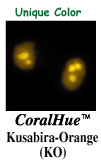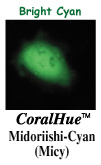Fluorescent Proteins
CoralHue® fluorescent proteins have been isolated from stony coral and emit a brilliant and stable fluorescence. MBLI highly recommends these exceptional fluorescent proteins for optical marking, labeling of subcellular structures, and protein migration.
Benefits of using CoralHue® fluorescent proteins include:
- Brightly colored fluorescent proteins
- Direct expression in cells without cytotoxicity
- Numerous citations


MBLI offers fluorescent protein-based indicators such as Fluoppi for protein-protein interaction, FUCCI for cell cycle and Keima-Red for autophagy/mitophagy.
CoralHue™ series
 |
 |
 |
 |
 |
 |
 |
 |
Upon purchasing fluorescent Protein Vector you need to agree to and sign the attached License Acknowledgement. Please note that the product will be shipped after we receive a completed and signed License Acknowledgement. Prior to shipping, our staff may contact you to verify the intended use of the product. Please also note that a separate agreement or a contract may be required depending on the intended use.
The product you have ordered is sold for research purpose only. It is not intended for industrial or clinical use, and shall not be used for any purposes other than research. You are also asked not to hand over or resell the product to a third party.
If you belong to a profit organization or a business corporation, or wish to use the product for profit or commercial purposes, please contact us.
※1 Provided by Dr. Miyawaki Atsushi, Laboratory for Cell Function and Dynamics, BSI, RIKEN
※2 Provided by Dr.Tsutsui Hidekazu and Dr. Miyawaki Atsushi , Laboratory for Cell Function and Dynamics, BSI, RIKEN
※ Developed in the collaboration research with Laboratory for Cell Function and Dynamics, BSI, RIKEN(Team leader, Dr. Miyawaki Atsushi), and MBL possesses the license and deals in the products.
We offer a wide variety of anti-CoralHue™ fluorescent protein antibodies.
Product list
| Fluorescent protein | Code No. | Product name | WB | IP | IC | IH | Clone | Isotype |
|---|---|---|---|---|---|---|---|---|
| Midoriishi-Cyan | M130-3M | anti-Midoriishi-Cyan | ○ | 5B7 | Mouse IgG1 | |||
| M116-3M | anti-Midoriishi-Cyan | ○ | 2C1 | Mouse IgG2b | ||||
| Azami-Green | M102-3M | anti-monomeric Azami-Green 1 | ○ | 2F11 | Mouse IgG1 k | |||
| PM011M | anti-Azami-Green | ○ | Polyclonal | Rabbit IgG | ||||
| PM052M | anti-monomeric Azami-Green 1 | ○ | ○ | ○ | ○ | Polyclonal | Rbbit Ig(aff.) | |
| Kusabira-Orange | M104-3M | anti-monomeric Kusabira-Orange 1 | ○ | 1H7 | Mouse IgG1 k | |||
| M168-3M | anti-monomeric Kusabira-Orange 2 | ○ | ○ | ○ | ○ | 3B3 | Mouse IgG1 k | |
| PM051M | anti-monomeric Kusabira-Orange 2 | ○ | ○ | ○ | ○ | Ployclonal | Rabbit Ig(aff.) | |
| Keima-Red | M126-3M | anti-monomeric Keima-Red | ○ | 2F7 | Mouse IgG2a | |||
| M182-3M | anti-Keima-Red | ○ | 1C3 | Mouse IgG1κ | ||||
| Kaede | M125-3M | anti-Kaede | ○ | 3B1 | Mouse IgG1 | |||
| PM012M | anti-Kaede | ○ | Polyclonal | Rabbit IgG | ||||
| M106-3M | anti-Kaede | ○ | 2F4 | Mouse IgG1 k | ||||
| Kikume Green-Red | M128-3M | anti-Kikume Green-Red | ○ | 5B3 | Mouse IgG2b | |||
| Kusabira-Green | M148-3M | anti-monomeric Kusabira-Green (N-ter) | ○ | 1E6 | Mouse IgG2b | |||
| M149-3M | anti-monomeric Kusabira-Green (C-ter) | ○ | 21B10 | Mouse IgG2a |
WB: western blotting, IP: immunoprecipitation, IC: immunocytochemistry, IH: immunohistochemistry
Antibodies cross-reactivity information
| Fluorescent protein | Product name | WB | Western Blot Cross reactivity |
clone | Isotype | Code No. | ||
|---|---|---|---|---|---|---|---|---|
| Midoriishi-Cyan | anti-midoriishi-Cyan | ◯ | MiCy, mMiCy | 5B7 | Mouse lgG1 | M130-3M | ||
| anti-midoriishi-Cyan | 2C1 | Mouse lgG2b | M116-3M | |||||
| Azami-Green | anti-monomeric Azami-Green 1 | ◯ | mAG1 | 2F11 | Mouse lgG1k | M102-3M | ||
| anti-Azami-Green | ◯ | AG, mAG1 | polyclonal | Rabbit lgG | PM011M | |||
| anti-monomeric Azami-Green 1 | ◯ | mAG1 | polyclonal | Rabbit lg(aff.) | PM052M | |||
| Kusabira-Orange | anti-monomeric Kusabira-Orange 1 | ◯ | mKO1, mKO2, mKG, mKG-O(1), mKOkappa(2) | 1H7 | Mouse lgG1k | M104-3M | ||
| anti-monomeric Kusabira-Orange 2 | ◯ | mKO2, mKG, mKG, mKG-O(1), mKOkappa(2) | 3B3 | Mouse lgG1k | M168-3M | |||
| anti-monomeric Kusabira-Orange 2 | ◯ | KO1, mKO1, mKO2, mKG, mKG, mKG-O(1), mKOkappa(2) | polyclonal | Rabbit lg(aff.) | PM051M | |||
| Kusabira-Green | anti-monomeric Kusabira-Green N-terminal fragment |
◯ | mKO1, mKO2, mKG | 1E6 | Mouse lgG2b | M148-3M | ||
| anti-monomeric Kusabira-Green C-terminal fragment |
◯ | mKO2, mKG | 21B10 | Mouse lgG2a | M149-3M | |||
| Keima-Red | anti-monomeric Keima-Red | ◯ | mKeima-Red | 2F7 | Mouse lgG2a | M126-3M | ||
| Kaede | anti-Kaede | ◯ | Kaede | 3B1 | Mouse lgG1 | M125-3M | ||
| anti-Kaede | ◯ | Kaede | polyclonal | Rabbit lgG | PM012M | |||
| anti-Kaede | 2F4 | Mouse lgG1k | M106-3M | |||||
| Kikume Green-Red | anti-Kikume Green-Red | ◯ | KikGR, mKikGR | 5B3 | Mouse lgG2b | M128-3M | ||
Learn more about Fluorescent Proteins & Technologies
CoralHue® Fluorescent Proteins
CoralHue® fluorescent proteins have been isolated from stony coral and emit a brilliant and stable fluorescence.




